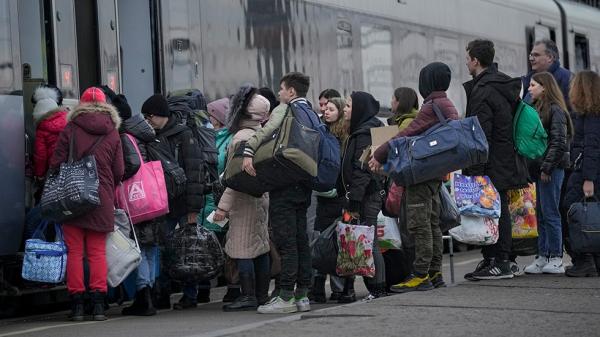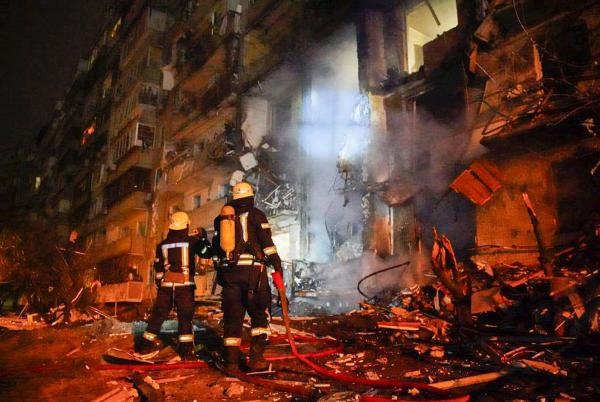
Friday, Feb. 25, 2022, firefighters at a building following a Russian rocket attack on the city of Kyiv, Ukraine. Photo: AP
The rulers of the U.S. and Russia, and their respective propaganda machineries, are warping, inventing, covering up, distorting, and spinning conflicting narratives of how a potentially catastrophic Russian invasion of Ukraine came about. This timeline presents an objective, reality-based picture of how things got to the horrific situation we are at today with the Russian invasion of Ukraine.
Download PDF of this article: Color | B&W
CONTENTS:
What is the historic relationship between Ukraine and Russia?
A) 1917-1933: Uprooting National Oppression
B) Reversal of Revolutionary Nationality Policies, 1933-1945
What about accusations that Stalin deliberately starved the people of Ukraine?
How does the restoration of capitalism in the Soviet Union frame the current conflict over Ukraine?
What is the significance of the collapse of the Soviet Union and NATO expansion post 1989?
What is the immediate background to the current crisis?
Where do the interests of humanity lie in the current situation?
Where Is Ukraine located?

Ukraine is second only to Russia in size in Europe. To the west: Poland, Slovakia, Hungary and Romania, countries that are part of the U.S.-led NATO military alliance. To the east, it shares a 1,700 mile border with Russia.
Ukraine is a large country (second only to Russia in size in Europe). To the west, it borders Poland, Slovakia, Hungary and Romania, countries that are part of the U.S.-led NATO military alliance, and where U.S. or allied troops are stationed. To the north, Ukraine is bordered by Belarus, a country generally aligned at this point with Russia (and engaged in joint military exercises with Russia).
To the east, Ukraine shares a 1,700-mile land and sea border with Russia, slightly less than the length of the U.S.-Mexico border. The “sea” part of the border, on the Black Sea, is a waterway strategically important to Russia's and Ukraine's imports and exports. Ukraine is referred to as being in Eastern Europe but taking into account the large size of European Russia to the east, Ukraine is geographically located centrally in Europe.
What is the historic relationship between Ukraine and Russia?
Like much of Eastern Europe, the borders and identity of what is today Ukraine were historically fluid. With its fertile plains and rich soil, Ukraine was known historically as the breadbasket of Europe and coveted by competing powers including the Polish-Lithuanian Commonwealth—which, at its peak in the early 17th century, encompassed a huge swath of Ukraine. But parts of Ukraine were also occupied by Hungary, the Ottoman (Turkish) empire, Sweden, bands of Russian Cossacks (basically armed gangs) and in more recent history the armies of successive Russian czars (brutal, anti-enlightenment feudal despots).1
By the end of the 18th century, Ukraine came under the domination of the huge Russian empire ruled by the czar. Russia’s rulers exploited Ukraine’s rich resources including coal, metal and grain production to serve Russia.
Russian occupation, and resistance to it, cohered Ukrainian nationalism which was suppressed by the czar’s secret police. The czars referred to their dominion as “little Russia” and tried to crush surging Ukrainian nationalism in the 1840s, for example banning the use of the Ukrainian language in schools.2
What was the impact of the 1917 socialist revolution in Russia on Ukraine and other formerly oppressed nations/nationalities?
A) 1917-1933: Uprooting National Oppression
The earthshaking, liberatory socialist revolution of October 1917 in Russia, led by the communist leader V.I. Lenin, overthrew the bourgeois, capitalist-imperialist regime that had come to power in February 1917 amidst the dislocation and revolutionary upheaval of World War 1 (1914-1918).
The world's first socialist society was now being forged. The world's first multinational state based on equality of nations, cultures and languages was established. The policy adopted and insisted on by Lenin was self-determination for the formerly oppressed nations and minorities who joined together in the Union of Soviet Socialist Republics (USSR), meaning that the unity of the new socialist state had to be voluntary.3
Republics of the Soviet Union

Click to enlarge.
By 1922, the new Soviet state became a Union of Soviet Socialist Republics (SSRs). Ukraine was one of many founding republics of this Union (which also included a great number of self-governing/autonomous territories of formerly oppressed nationalities). Library of Congress
The socialist revolution of 1917 involved the people of Ukraine; and so too the civil war that followed in the years 1918-21. By 1922, the new Soviet state became a Union of Soviet Socialist Republics. Ukraine was one of the 12 large founding republics of this Union (which also included a great number of self-governing/autonomous territories of formerly oppressed nationalities).

New collective farms, like the one here where workers are holding a discussion, transformed the old, private exploitative system of agriculture that could not reliably feed the population. Collectivization in the late 1920s and early 1930s was also a great social upheaval that challenged old customs and brought the poorest of peasants into political life.
The Soviet revolution under Lenin's leadership, and later Joseph Stalin’s, instituted bold and radical measures to overcome inequality and discrimination. Education was carried out in native languages; efforts were made to bring forward indigenous, local leadership in the formerly oppressed nations, and the Soviet state financed the mass production of books, journals, newspapers, movies, operas, folk ensembles and more in non-Russian languages. Economic resources were provided to less developed regions, where minority nationalities lived. At the same time, the Soviet state launched education and ideological struggle against what was called Great Russian chauvinism (the belief in the superiority of the Russian people and their right to dominate and oppress other nationalities).


A major focus of socialist transformation in the Soviet Union was the liberation of women. In 1927, the Communist Party launched a movement to overthrow deeply rooted, brutally oppressive traditions imposed on women in the Central Asian Soviet republics, including marrying young girls to old men, and men having multiple wives. In Uzbekistan, Tajikistan, and Azerbaijan, women were backed by the revolutionary state to cast off heavy head-to-toe coverings of horsehair and cotton that Muslim women and girls over the age of 9 or 10 were forced to wear in the presence of men outside their families. The photo on the right of a young, liberated Uzbek woman was taken by the poet Langston Hughes who toured the Soviet Union with other African-American artists and literary figures in 1932-1933.
In Ukraine, policies to overcome national oppression flourished from the early 1920s to the early 1930s. It became a kind of laboratory and model for other parts of the Soviet Union. Special measures were also taken to protect the rights and cultures of, and to give economic support to, minority nationalities and groupings within Ukraine—like the Jewish people, Romas (Gypsies) and others. With all the transformation and experimentation taking place, there were tensions and problems, missteps, lessons to be learned. There was struggle for the new and resistance from the old. Yet and still, something truly emancipating was being created. For an overall picture of how the Bolshevik (socialist) revolution impacted oppressed nationalities, see You Don't Know What You Think You "Know" About... The Communist Revolution and the REAL Path to Emancipation: Its History and Our Future, an interview with Raymond Lotta.4
B) Reversal of Revolutionary Nationality Policies, 1933-1945
By the mid-1930s, the Soviet revolution was facing grave threats. In 1931, imperialist Japan invaded Manchuria (a region of China) on the Soviet Union's border. In 1933, the Nazis consolidated power in Germany—making clear their intention to destroy and occupy the world's first socialist state. There were real and monumental dangers. But there were serious mistakes and problems, and grievous errors, in how the Soviet leadership under Stalin responded.
The Soviet leadership placed a premium on building unity to face these threats. And this unity was forged around a kind of national patriotism (in place of revolutionary internationalism). Russian nationalism was relied on to mobilize people to oppose and defeat the Nazi invasion of the Soviet Union (which took the lives of around 26 million Soviet people).
Many of the nationality policies promoting ethnic diversity were revised and reversed through the 1930s. Emphasis was placed on the teaching and learning of the Russian language. Russian culture was extolled. Policies of indigenous leadership were reined in. With this came some ugly chauvinist measures against some nationalities who were regarded as potential collaborators with external enemies.
These policies and the orientation behind them are examples of what Bob Avakian (BA) has called “truths that make us cringe.” This refers to grievous mistakes and errors made by revolutionary leaders. These must be scientifically analyzed, as BA has done through the new communism that he has developed: what were the real contradictions and challenges faced by the revolution and its leadership, and what was wrong in the method and approach of leadership that led to such policies?
On the basis of undertaking that examination, BA has identified underlying dynamics, conflicts and tensions between advancing the revolution both around the world and within the socialist society on the one hand, and defending the socialist state when it does come under direct threat and attack—as the Soviet Union actually did, in bearing the brunt of the Nazi onslaught in World War 2. The breakthrough BA has made on this can be read about in his works Conquer the World, “Advancing the World Revolutionary Movement: Questions of Strategic Orientation” and Breakthroughs.
Contrary to the lies of imperialism, the Soviet leadership did not “exterminate” minority nationalities. And it should not be forgotten that the Soviet Union was the only country in the 1930s and 1940s to enact measures and policies to save the lives of Jewish people on a vast scale.5

Photo: 1943, Soviet soldiers attack NAZI positions in the battle of Stalingrad in the Soviet Union (today that city is called Volgograd). Nearly two million people were killed or injured this battle which played a key role in in defeating the NAZIs and turning the tide in World War II. In the face of an existential threat to the Soviet Union and humanity, there were grievous errors on the part of the Soviet leadership under Stalin including a reliance on patriotism in opposition to internationalism, and reversed policies that had placed a premium on overcoming national oppression within the Soviet Union.
What about accusations that Stalin deliberately starved the people of Ukraine?
A big line of attack on the socialist revolution in the Soviet Union of 1917-56 concerns the famine that took place in Ukraine in 1932-1933. Anti-communist historians, Ukrainian reactionaries, and the Western media in general charge that Joseph Stalin, who led the Soviet Union from 1927 to 1953, deliberately starved the people of Ukraine.
The accusation that Stalin wanted to punish and wipe out large numbers of Ukrainian peasants and the general Ukrainian population by intentionally denying them grain is a lie—a calculated misrepresentation of reality that gets mindlessly repeated. Here are some key points of truthful understanding:
There was a terrible famine in Ukraine (but also other regions of the Soviet Union) in the early 1930s. Many people died. But the famine was mainly caused by a decline in grain production. This decline was mainly caused by unfavorable weather, disease to crops, and other natural factors. The food shortages, however, became worse because of serious errors in government policy. How so?
Ukraine was the most critical grain-producing region of the entire Soviet Union—and this grain was important to meet the nutritional needs of the Soviet population, especially in the cities, and people in the military. But the government had been making excessive demands on peasant-collective farmers in Ukraine to raise output and transfer unrealistically large amounts of grain to the central government, which distributed grain to cities and elsewhere. There was not enough grain kept for emergency reserve for Ukrainian peasants. The government eventually lowered grain delivery requirements and sent food relief to the areas that were suffering acute food shortages.
The actual facts of the 1932-33 famine versus anticommunist distortions, and evidence-based analysis of Soviet agricultural policy under Stalin, are set out on the Set the Record Straight website, in the research paper: “The Famine of 1933 in the Soviet Union: What Really Happened, Why it was NOT an ‘Intentional Famine.'”
How does the restoration of capitalism in the Soviet Union frame the current conflict over Ukraine?
Representatives of the interests of the U.S. empire, including “experts” in academia and in the media, insist that the clash between Russia and the U.S. over Ukraine is a continuation of a long history of conflict between “democracy” and “communism,” or, as they are branding that now, a conflict between democracy and “authoritarianism.” This is utter hypocrisy given the crimes carried out by this country around the world.6
As Bob Avakian wrote in “Shameless American Chauvinism: ‘Anti-Authoritarianism’ as a ‘Cover’ For Supporting U.S. Imperialism”:
Somehow, these “enlightened historians” have lost sight of the fact that the country they are living in (the “good old USA”) established, and repeatedly expanded, its territory on the basis of predatory violence on a massive scale, including genocidal “military campaigns” against the indigenous peoples of this continent (repeatedly breaking treaties in the process), and an expansionist war of aggression which resulted in ripping off a huge part of the territory of Mexico, in the middle of the 19th century, largely for the purpose of expanding slavery. And, after all, this is a country where a “manifest destiny” was declared—to conquer territory “from sea to shining sea” (and beyond). (Read and share this entire piece).

U.S. “experts” who claim Russia’s invasion of Ukraine is driven by “authoritarianism” seem to have forgotten that their own country—the U.S.A.—seized a huge part of Mexico in the mid-1800s to expand slavery.
The actual roots of the present conflict are framed by the restoration of capitalism in 1956 in the Soviet Union and its emergence as a global capitalist-imperialist power in conflict with the capitalist-imperialist U.S. empire in what is called the “Cold War.”7
The Soviet Union came out of World War 2 victorious. But socialism was greatly weakened politically and ideologically. This was not a vibrant revolutionary society. In the mid-1950s, following Stalin's death, new bourgeois forces within the Communist Party maneuvered to seize power and consolidated the rule of a new capitalist class. They restructured the Soviet Union into a state-capitalist society. The major means of production—factories, infrastructure, etc.—and banks remained government/state-owned, but profit was put in command. The new rulers maintained a socialist facade as they mounted an imperialist challenge to Western imperialism.
BA has concisely and scientifically explained what imperialism is, and the nature of conflicts between imperialist powers:
Imperialism means huge monopolies and financial institutions controlling the economies and the political systems—and the lives of people—not just in one country but all over the world. Imperialism means parasitic exploiters who oppress hundreds of millions of people and condemn them to untold misery; parasitic financiers who can cause millions to starve just by pressing a computer key and thereby shifting vast amounts of wealth from one place to another. Imperialism means war—war to put down the resistance and rebellion of the oppressed, and war between rival imperialist states—it means the leaders of these states can condemn humanity to unbelievable devastation, perhaps even total annihilation, with the push of a button. (From We Have a World to Win, 1999)
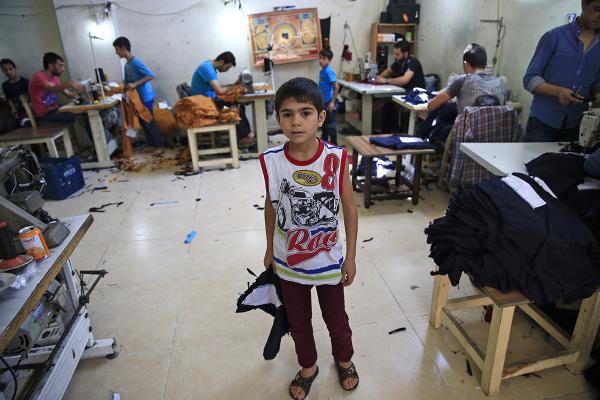
Imperialism means parasitic exploiters who oppress hundreds of millions of people and condemn them to untold misery and war. Above: Syrian refugees, including children, driven from their homeland by a war where both the U.S. and Russia carried out massacres, working in a sweatshop in Turkey. Photo: AP
In that context, two rival economic and military blocs faced off in Europe. On one side, the U.S. and the nations aligned with it. Most of the countries aligned with the U.S. were part of the U.S.-led NATO military alliance. On the other, countries that had been occupied by the Soviet Union after World War 2, including East Germany, Czechoslovakia, Hungary and Poland, were part of the rival military alliance, the Warsaw Pact.
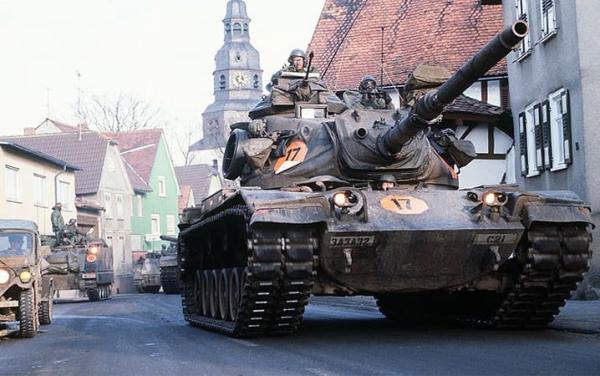
NATO tanks in West Germany, 1985. Photo: US Army
Within the (imperialist) Soviet Union itself, Ukraine—next to Russia the largest and most economically developed republic—played an outsized role in contributing to the economic (and thus the basis for the) military strength of the Soviet Union and its bloc.8
What is the significance of the collapse of the Soviet Union and NATO expansion post-1989?
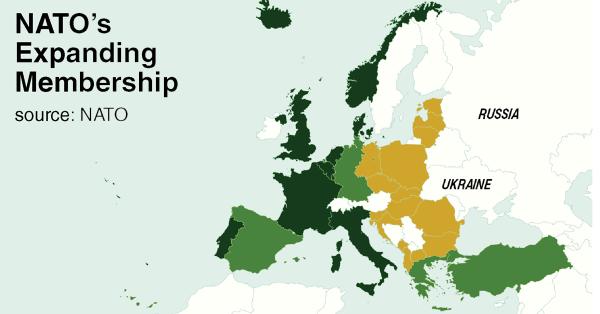
NATO's expanding membership, revealing the systematic encirclement of Russia by countries hosting U.S. and allied troops, planes and missiles. Dark green countries became part of NATO in 1949; lighter green countries joined NATO between 1952 and 1982; countries in light orange joined between 1990 and 2020. Source: NATO
In a surprising development, moves towards world war between the two superpowers and powerful economic and political contradictions within Soviet society and within that ruling class led to the rapid collapse of the Soviet Union in the period 1989-1991.9 It was not real socialism-communism that collapsed but the state-capitalism parading as socialism that imploded.
The U.S. and its allies welcomed the collapse of their capitalist-imperialist rival. And even though the Soviet Union had long-since restored capitalism, the rulers of the U.S. saw an opportunity to declare the “death of communism.” They attempted to facilitate the collapse of the Soviet Union by backing forces in the Russian ruling class that wanted to jettison any pretense of being a socialist country and restructure the country on openly capitalist terms and initially offered inducements to deal with the West. In February 1990, U.S. Secretary of State James Baker and Soviet leader Mikhail Gorbachev discussed NATO’s future role in the context of a unified Germany. Baker told Gorbachev that “there would be no extension of NATO’s jurisdiction for forces of NATO one inch to the east.”10
The collapse of the Soviet Union led to the disintegration of the Warsaw Pact, and the establishment of many independent nations out of what had been the Soviet Union. In 1991, Ukraine became an independent country.
By the late 1990s, the Russian-dominated economic and military camp splintered and pro-Western forces came to power in many of those countries. Despite promises made by the U.S., NATO began expanding to the east. In 1999 the Czech Republic, Hungary and Poland were absorbed into NATO. In 2004, Bulgaria, Estonia, Latvia, Lithuania, Romania, Slovakia, and Slovenia were added to NATO. Since then, the rapid expansion of NATO to Russia’s borders—Albania, Croatia, Montenegro and (in 2020) North Macedonia have been added to NATO’s rolls—posed the question of whether Ukraine would also join NATO.
The expansion of NATO, and the U.S. insistence on the “right” to bring Ukraine into the NATO military alliance in Europe, is a major factor in the Ukraine crisis. Expanding NATO into Ukraine would potentially put U.S. forces and nuclear weapons on the borders of Russia. And NATO is far from a “defensive” alliance as the U.S. claims: NATO forces played a major role in the U.S.-led invasion and occupation of Afghanistan that killed or injured hundreds of thousands of people and drove millions from their homes. NATO forces dropped nearly 10,000 bombs on Libya to force regime change there in 2011.
Several NATO countries border Russia, and taken together encircle much of European Russia, armed with Western European state-of-the-“art” deadly weapons. Bringing Ukraine, with its extensive border with Russia into NATO, would tremendously amplify the threat to Russia. 11
And here it must be noted that in October 1962, the U.S. faced an analogous situation when Russia (then the Soviet Union) placed missiles in Cuba. In response, the U.S. took the world to the brink of nuclear war over the course of 12 days to force them out—experts believe this was “the closest point that the world had ever come to global nuclear war.”12
What is the immediate background to the current crisis?
From the time of the collapse of the Soviet Union, Ukraine has been a focus of a fierce and escalating tug-of-war between the U.S. and Russian capitalist-imperialist powers, driven by an assessment by both the U.S. and Russia that Ukraine is a key link in each of their needs to establish a dominant position vis-à-vis their imperialist rival. The overall trajectory has been pulling Ukraine more and more, economically, and militarily, into the orbit of the U.S.
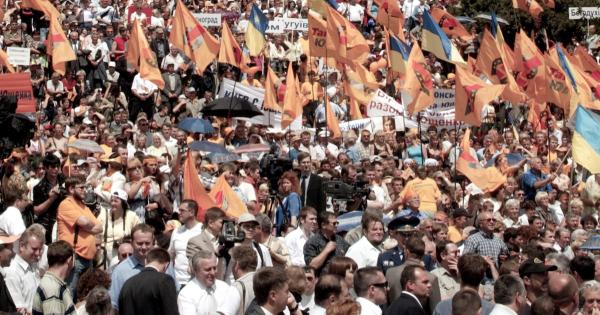
In 2004, the U.S. backed what was branded as the “Orange Revolution,” ostensibly a popular revolt but funded and orchestrated by the U.S. to drive a pro-Russian president from office.
Key nodal points on that trajectory include:
- In 2004, a pro-Russian candidate, Viktor Yanukovych, was elected president of Ukraine. In response, the U.S. backed what was branded as the “Orange Revolution,” ostensibly a popular revolt but funded and orchestrated by the U.S. to drive Yanukovych from office.13 In a close “rerun” of the election, he was replaced by a pro-U.S. candidate.14
- In 2006, Russia “sent a message” by briefly cutting off natural gas supplies to Ukraine claiming Ukraine was behind in payments.
- In 2008, NATO expressed a commitment to integrate Ukraine. This would move the U.S.-led military alliance directly onto the Russian border. To appreciate the impact of this, imagine the response of the U.S. ruling class if Russia or China were moving to place a military base in Tijuana.
- In 2010, Yanukovych (the pro-Russian former leader) was re-elected in what was considered a legitimate presidential election,15 and Russia and Ukraine signed a gas pricing deal in exchange for the extension of a lease for the Russian navy in a Ukrainian Black Sea port in Crimea.
- In 2014, Ukraine was wracked by severe economic crisis, heavily in debt to both the U.S.-dominated International Monetary Fund (IMF) and Russia.16 Both the U.S. and its allies on one side, and Russia on the other, moved to exploit the crisis (which both sides were largely responsible for) and blackmail and bribe the Ukraine government into a closer alliance.17 On February 22, 2014, the Ukrainian government agreed to a Western aid package led by the IMF.18 In the midst of this crisis, through complex international diplomacy and intrigue, Yanukovych was driven out of office.
- Alarmed by this movement of Ukraine into closer integration into U.S.-allied Western Europe, Russia invaded and annexed the small Ukrainian region of Crimea in 2014, which it saw as vital to protecting its access to Black Sea shipping.
Since then, the U.S. has moved to consolidate Ukraine into its orbit more tightly, sending billions of dollars of economic aid and weapons, and creating more incentives for Ukraine to turn more sharply to the West. And Russia has moved to undermine the Ukrainian government, including sponsoring a pro-Russian armed insurgency in areas on the Russian border, and by pressuring the Ukrainian government with massive mobilization of troops on the Ukraine-Russia border.
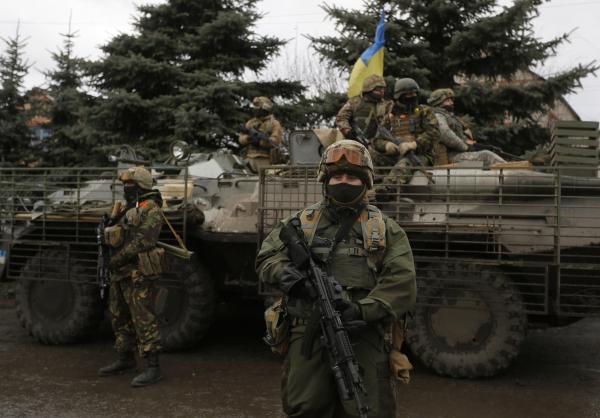
Russia has backed separatists in eastern Ukraine who are fighting the Ukrainian government with mostly small arms and light weapons. The U.S. has provided billions of dollars of military aid to the Ukrainian army (shown here fighting the separatists) including training, sophisticated radars, and missiles. Photo: AP
At the beginning of 2022, the U.S. released almost daily intelligence reports declaring Russia would invade Ukraine. While ostensibly this “transparent” sharing of U.S. intel was to make the world aware of the danger of, and prevent war, the more underlying intent was to firm up the backing of Germany and other Western powers for crippling sanctions and other moves against Russia. Some have argued that whatever the intent, or even despite the intent of the U.S., these releases had a contradictory provocative effect of "backing" the rival imperialist-gangster into a corner.19
On February 23, Russia launched its utterly unjustified and bloody invasion of Ukraine with the horrific consequences we see today.
Where do the interests of humanity lie in the current situation?
The Russian invasion of Ukraine has absolutely nothing to do with taking back a part of the Russian nation nor is it about “de-Nazification” as Putin claims. It is a move by Russian imperialism to bring back into its bloc a nation that the U.S. was steadily aiming to pull away and turn into an outpost against Russia. It is a move to strengthen itself to contend in a world where the old imperialist division of the world is increasingly contested.
For its part, the U.S. has armed the Ukrainians to fight the Russians, it has sent troops and advanced weapons systems to surrounding countries, and it is now moving to isolate and cripple the Russian economy. All this has nothing to do with “seeking peace,” but is part of a strategy to both weaken Russia through enabling Ukraine to put up resistance while America, for now, stays out of direct battle; and it is a way for the U.S. to strengthen its grip on its alliance.
The interests of humanity lie NOT with either imperialist bloc. Bob Avakian has said:
The interests, objectives, and grand designs of the imperialists are not our interests—they are not the interests of the great majority of people in the U.S. nor of the overwhelming majority of people in the world as a whole. And the difficulties the imperialists have gotten themselves into in pursuit of these interests must be seen, and responded to, not from the point of view of the imperialists and their interests, but from the point of view of the great majority of humanity and the basic and urgent need of humanity for a different and better world, for another way. (BAsics 3:8)
And with the Russian invasion of Ukraine, and the ensuing horrible suffering and death, Bob Avakian has posed this challenge in the piece “Shameless American Chauvinism: ‘Anti-Authoritarianism’ as a ‘Cover’ For Supporting U.S. Imperialism”:
What is called for, and urgently now, is to oppose all imperialist marauders and mass murderers, and all systems and relations of oppression and exploitation, while giving particular emphasis to opposing “our own” imperialist oppressors who commit their monstrous crimes “in our name” and seek to rally us to support them on the basis of a grotesque American chauvinism, which we must firmly reject and fiercely struggle against.
For coverage and analysis of the evolution of the specific crisis right now and the danger of war, see ongoing coverage at revcom.us and follow events on The RNL—Revolution, Nothing Less!—Show on YouTube.
